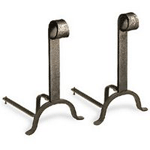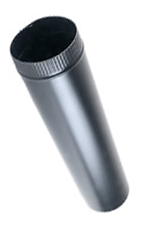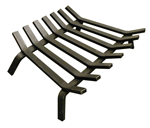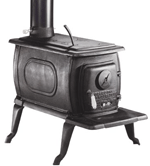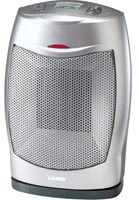DIY Frequently Asked Questions
Heating & Cooling Terms
Whole-House Fan
 Draws hot air from the living area into the attic where it is vented outside.
Draws hot air from the living area into the attic where it is vented outside.- Installation and operation costs less than an air conditioner.
- Keeps a gentle breeze stirring throughout the house and can make the temperature seem 2° to 3° cooler.
- Has louvers that open automatically when the fan is turned on and close when it is turned off to seal out outside air.
- Rated according to the measurement of cubic feet of air per minute (CFM) that it moves.
- Fans with variable-speed motors cool the house at higher speeds and maintain general air circulation when turned down.
Evaporative Humidifier
 Uses a wick and high-volume air to return moisture to the air.
Uses a wick and high-volume air to return moisture to the air.- The wick is a honeycomb arrangement of cellulose paper with a large surface area.
- Operates by partially submerging the wick in the water while a fan forces air to pass through the upper exposed area, distributing absorbed water into the air.
- Wicks will need replacing.
- This type uses little energy and is easy to clean. Some units can be noisy.
Warm-Mist Device
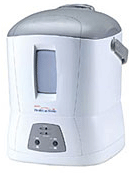 Uses a heating element to restore moisture to the air.
Uses a heating element to restore moisture to the air.- The water surrounding the heating element is brought to near boiling and a fan cools and distributes the moistened air, which is slightly warmer than room air.
- This type can be used with tap water and will not cause white dust.
- Can be noisy and consumes more energy than other types.
Evaporative Cooler
 Sometimes called a swamp cooler.
Sometimes called a swamp cooler.- Uses ice and cool water to cool and return moisture to the air.
- Ice and cool water is mounted on top of the unit. As the ice melts, cool water flows over a wicking material. A fan mounted behind the wick creates a cool moist breeze.
- Environmentally friendly as it uses little energy and contains no harmful chlorofluorocarbons.
- Crack a few windows to prevent moisture build-up on inside walls when using an evaporative cooler.
Dehumidifier
 Removes excess moisture from the air by blowing humid air over cold evaporator coils in a refrigerator system.
Removes excess moisture from the air by blowing humid air over cold evaporator coils in a refrigerator system.- Moisture collects in a pan, and the unit will automatically shut off when the pan is full.
- A humidistat controlling the dehumidifier will respond to changes in moisture content and is necessary for efficient energy consumption.
Window-Mounted Air Conditioner
 Cools, circulates, filters and dehumidifies the air.
Cools, circulates, filters and dehumidifies the air.- Ranges in size from small units with a cooling capacity of 5,000 BTUs (enough to cool a small room) to capacities as high as 12,500 BTUs.
- It is important that you choose the right size of air conditioner. An oversize unit will cool but leave a damp and clammy feeling because of high relative humidity. An undersized unit will not operate effectively on very hot days.
- Select by BTU rating, not horsepower. BTU is the actual cooling capacity of the unit.
- Determine the efficiency of the unit by dividing the watt rating into the BTU output. The unit must have an energy efficiency rating (EER) of at least 9.7 for models under 8,000 BTU/hr and 9.8 for larger models. The most efficient models have an EER of 11 and higher. Each model should have its EER clearly marked.
- Most models should include window-mounting kits. Kits include sill brackets for extra support of the unit and side vents to ensure an airtight fit in the window.
- Make sure the unit is designed for the type of window you have. Most are designed for double-hung windows, but some are made or casement windows or for in-wall installation.
Portable Air Conditioner
 Used to cool a small space, usually 400 to 450 square feet.
Used to cool a small space, usually 400 to 450 square feet.- Mounted on wheels for easy movement from room to room.
- Contains both the hot and cold side of the air conditioner in one unit. Is not permanently installed, but must be connected to some place like a window where the hot air can be vented. Most models contain window-venting kits that are easy to install and easily moved from one window to another.
- May be either single or dual vent. Dual vent models circulate clean air back into the room and generally cool more quickly than single vent models.
- Drip models have a tray that will need to be emptied every 24-48 hours. No-drip models may cost more but do not produce any excess moisture.
Window Fan
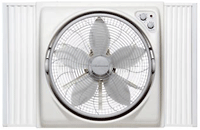 Uses less energy than air conditioning and contains no chlorofluorocarbons.
Uses less energy than air conditioning and contains no chlorofluorocarbons.- Brings fresh air into the room while expelling hot air.
- Typical size is 20”.
- Larger window fans require mounting kits and side panels. The panels support the fan and prevent air from circulating around and back into the fan, resulting in a loss of performance.
- Smaller units are easiest to install, as they come with the panels attached to the fan.
- Used to intake and exhaust, for bringing inside air into a room or expelling inside air out of a room. Better models have electrical reversibility, which allows the user to switch from exhaust to intake without turning the fan around.
Floor Fan
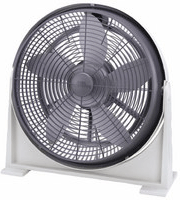 Can be moved anywhere in the home to provide air movement that will cool and circulate air.
Can be moved anywhere in the home to provide air movement that will cool and circulate air.- Sizes are generally 10” to 12” in diameter. They can be mounted in rectangular or round, hassock-type case.
- A hassock fan throws air outward and upward in a 360° direction.
- A rectangular fan will tile about 170° and may be used as a table fan, throwing air outward.
- Typically has a speed-selection control, while some may run at a fixed speed.
- One variation is the stand-mounted fan. This type can generally be easily tilted and may be used as an exhaust fan if placed near a window.
Oscillating Fan
 Moves back and forth in an adjustable pattern to spread air over a larger area.
Moves back and forth in an adjustable pattern to spread air over a larger area.- Oscillation function can generally be switched off with the turn of a knob.
- May be used on the floor, a table or mounted on the wall.
- Usually does not have as high an air delivery as floor fans.
- Typically ranges in size from 8” to 16” in diameter.
- Tile angle varies from about 50° to 90°.
Exhaust Fan
 Used primarily to extract stale air from an attic, kitchen or bathroom.
Used primarily to extract stale air from an attic, kitchen or bathroom.- Kitchen fans are installed above the kitchen range or under the range hood and prevent smoke and grease from accumulating in the kitchen and spreading throughout the house. A switch simultaneously starts the fan and opens an outside vent.
- Bathroom fans may come with an optional light or heater and are used to expel steam and odors from the rooms.
- Should carry certified sound ratings developed by the Home Ventilating Institute and its member manufacturers. Ratings are in steps of 0.5 sones and 10 (CFM) cubic feet per minute. Limits for sound outputs are 6.5 sones for bathroom fans and 9 sones for kitchen fans up to 500 cfm.
Ultrasonic Humidifier
 Uses high-frequency energy to break the water up into tiny droplets, which are then dispersed into the air by a small fan.
Uses high-frequency energy to break the water up into tiny droplets, which are then dispersed into the air by a small fan.- Quiet and use little energy.
- Has the potential of leaving a sticky white dust around the house if used with hard tap water.
- Can pose health risks if the unit raises the level of airborne particles in the air.
- For best results and to prevent pollutants in the air, use distilled water with this type of humidifier.
Ceiling Fan
 Creates a gentle indoor breeze and supports heating and air conditioning systems by using less energy than a 100-watt light bulb requires.
Creates a gentle indoor breeze and supports heating and air conditioning systems by using less energy than a 100-watt light bulb requires.- Typical sizes are 36”, 42”, 48” and 52”, and some industrial models are as large as 56” to 72”.
- Many models combine the fan with a light fixture.
- Most ceiling fans have variable speed controls.
- Standard mounting kits are available for ceilings as low as 8’ and close to-the-ceiling models can be used on 7’-6” high ceilings.
- Blades may be real wood, metal or plastic.
- Heavy-material motor housings will aid fan efficiency as the additional mass gains more momentum, reducing the energy necessary to keep the fan in motion.
HEPA Air Cleaner
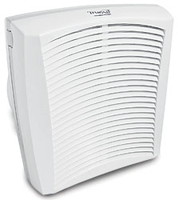 Passes air through a filter to remove pollen, dust and other airborne allergens.
Passes air through a filter to remove pollen, dust and other airborne allergens.- Uses a high-efficiency-particulate-arresting (HEPA) filter.
- Often used in medicine, atomic energy and semiconductors because of their superior air-cleaning ability.
- Can trap as much as 99.97 percent of particles 0.3 microns or larger.
- Designed to trap allergy-causing pollen and mold spores, as well as filter out smoke and dust mites.
UV Air Cleaner
 Uses a HEPA filter as well as ultraviolet light rays to clean air.
Uses a HEPA filter as well as ultraviolet light rays to clean air.- Also acts as a germ killer to remove virus, mold and bacteria from the air.
- Some units have a pre-filter as the first line of defense against larger particles. It is the less expensive filter and extends the life of the more expensive HEPA filter.
Fiberglass Filter
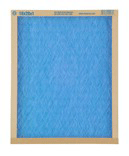 Designed to protect the heating and air conditioning system from large particles, heavy dust and lint.
Designed to protect the heating and air conditioning system from large particles, heavy dust and lint.- Protects furnace from larger particles and lint that enter the HVAC system.
- Most common type of filter.
- Fibers are not dense or electrostatically charged, so they cannot attract and capture smaller-sized particles.
- This type of filter should be changed at least once a month.
- Most common size for all furnace/AC filters are 20”x 20”, 20”x 25”, 16”x 20”, 16”x 25” and 14”x 25″.
Pleated Filter
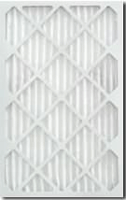 A low-cost alternative to fiberglass filters, designed to protect the home’s HVAC system from dust.
A low-cost alternative to fiberglass filters, designed to protect the home’s HVAC system from dust.- Made of a dense and efficient cotton/polyester material.
- The pleated design provides greater surface area to capture more particles than fiberglass filters.
- Smaller sized particles can pass through the filter because fibers are not eletrostatically charge and the media must be woven with spaces between fibers to allow adequate airflow.
- This type of filter should be changed every 90 days.
Electret Filter
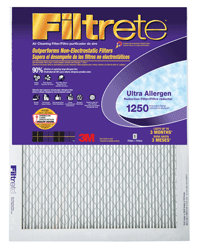 More expensive than other types of filters, but also removes more particles than other types of filters. Also helps protect the heating and cooling system mechanical parts from dust, which helps extend its life.
More expensive than other types of filters, but also removes more particles than other types of filters. Also helps protect the heating and cooling system mechanical parts from dust, which helps extend its life.- Electrostatically charged. Contains “sites” that carry a permanent electrostatic charge. Sites attract and capture sub-micron-sized particles, as well as larger particles.
- Captures large airborne allergens like household dust, pollen and mold spores.
- Also captures microscopic allergens like pet dander, smoke and smog. Some manufacturers produce models that can capture bacteria and particles that can carry viruses.
- Disposable. Should be changed every three months.
Permanent Washable Filter
 Consists of a flat panel of various woven synthetics.
Consists of a flat panel of various woven synthetics.- Considered permanent because homeowners can rinse it free of particles and reuse it.
- Should be rinsed every 30 days. Filter usually lasts 5-6 years.
- Some brands have an anti-microbial agent that inhibits growth of mold, mildew, bacteria and fungi in the filter.
- An electrostatic charge develops as air passes through the filter. The charge, however, varies with humidity and the furnace or A/C blowing cycles. This means some particles may fall off the filter, pass through it and re-enter the air stream.
Dial Thermostat
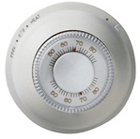 Controls the temperature in a room turning on or off the furnace or air-conditioner.
Controls the temperature in a room turning on or off the furnace or air-conditioner.- Temperature is set manually by a dial.
- One type is low-voltage. It uses power from a transformer that converts 120-volt power into 24 volts.
- Line-voltage thermostats are another type, and use the same power source as the units they control.
Digital Thermostat
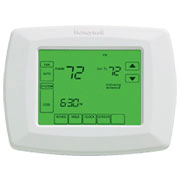 Controls the temperature in a room turning on or off the furnace or air-conditioner.
Controls the temperature in a room turning on or off the furnace or air-conditioner.- Temperature is set electronically.
- A popular type is a programmable thermostat that allows the use to preset temperatures for different times of the day.
- A popular replacement for dial thermostats because they use the same wiring.
What kind of caulk should I use around window frames?
Latex caulks are good for filling these kinds of gaps. They clean up with water and most are paintable. However, they must be applied in temperatures of more than 40 degrees.
Airtight Wood Stove
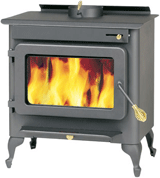 Has a sealed firebox and a tight-fitting door
Has a sealed firebox and a tight-fitting door- An air intake damper allows air to circulate around the firebox and controls the rate of fuel consumed. It can be manually or thermostatically controlled.
- Provides slow-burning heat for a long period of time with little attention.
- Prone to heavy creosote buildup in the chimney and pipes because it is slow burning.
Gas Stove
 Ideal for those with little space to store wood or with the time to maintain a wood stove. Also better for heating smaller areas.
Ideal for those with little space to store wood or with the time to maintain a wood stove. Also better for heating smaller areas.- Uses natural gas so it is a reliable heat source when the power goes out.
- Flame height and heat intensity is easily adjustable.
- The direct vent type is ideal for homes without an existing chimney.
Stove Paint
 Uses to touch up or completely refinish a stove.
Uses to touch up or completely refinish a stove.- Specifically designed for wood- or coal-burning stoves and can withstand temperatures up to 1,200°F.
- Common colors include green, brown, blue, maroon and black, in gegular and metallic finishes.
- To maximize radiant heat from the stove, use a flat black paint. It will radiate 90-98 percent of radiant heat. Shiny metallic finishes are less efficient.
Wood Fireplace
 Burns seasoned wood or manufactured wood logs to provide primary or secondary heat to a home.
Burns seasoned wood or manufactured wood logs to provide primary or secondary heat to a home.- Newer prefabricated fireplaces are more energy efficient than traditional masonry ones.
- Must use a venting system. In a conventional, open-face fireplace, the chimney serves as the vent. The drawback is that it pulls warm air up the chimney and out of the house.
- A prefabricated fireplace has an enclosed firebox made of a material that will hold some of the heat from the flue gases so more heat is radiated back into the room.
- Fireplace systems will incorporate a damper in the flue, which can be closed when the fire is extinguished. Otherwise, the warm air will continue to flow out of the house through the draft that is created.
Gas Fireplace
 Uses natural or LP gas.
Uses natural or LP gas.- Burns either natural or LP gas to provide primary or secondary heat to a home.
- Conventional models require a venting system and a smoke dome or chimney installed through the roof.
- Newer gas fireplaces can be vented through the wall using a power vent.
- Built-in units require no special flooring or hearth front.
- Can be converted to a wood-burning fireplace.
Vented Gas Log
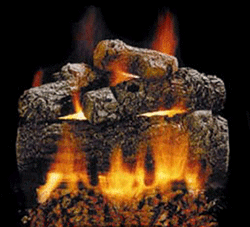 Requires a venting system and a smoke dome or chimney, installed on the roof.
Requires a venting system and a smoke dome or chimney, installed on the roof.- Operate at a range of 60,000 to 90,000 BTUs and loose heat as they require the chimney damper to be open.
- Made of high-temperature, heat-resistant ceramic or cement in a variety of finishes.
- Place directly on the fire grate or lay on a flame pan covered with a bed of volcanic granules for a more realistic looking fire.
- Requires no electricity to operate.
- Fits into fireplaces with a gas hookup and can be installed into any UL-listed, solid fuel burning fireplace.
Vent Free Gas Log
 Operates with the chimney damper closed, thus preventing heat-loss.
Operates with the chimney damper closed, thus preventing heat-loss.- Has an adjustable input with a maximum of 40,000 BTUs.
- Any unit made after 1980 includes an oxygen depletion sensor (ODS) that shuts off the heater and flow of gas if the oxygen level in a room becomes inadequate.
- Another safety feature is an automatic shut-off valve to shut off the gas flow if the pilot light is extinguished or the gas flow is interrupted.
- Made of high-temperature, heat-resistant ceramic or cement in a variety of finishes.
- Placed directly on the fire grate or lays on a flame pan covered with a bed of volcanic granules for a more realistic looking fire.
- Requires no electricity to operate.
- Fits into fireplaces with a gas hookup and can be installed into any UL-listed, solid fuel burning fireplace or in an
- American Gas Association (AGA) design-certified, vent-free fireplace listed for use.
Chimney Cleaner
 Cleans creosote, a potential fire hazard, out of chimneys.
Cleans creosote, a potential fire hazard, out of chimneys.- Soot destroyers can be used in wood- gas- coal or oil-burning fireplaces. They come in a powdered form, cylindrical sticks or aerosol spray cans. They are sprinkled on hot fires.
- Creosote removers, a second type, crystallize creosote in wood-burning stoves or fireplaces. They are available in powder form and are to be sprinkled on cool fires.
- Round wire brushes are another type of cleaner. Use them in wood burning, airtight stoves and fireplace chimneys.
Glass Enclosure
 Improves fireplace performance by controlling air intake, making the wood burn more slowly and retaining more heat in the firebox. Additionally, the fireplace pulls less warm air from the house.
Improves fireplace performance by controlling air intake, making the wood burn more slowly and retaining more heat in the firebox. Additionally, the fireplace pulls less warm air from the house.- Allows user to leave the fire unattended.
- Allows a clear view of the fire while keeping smoke and sparks out of the room.
- Most have a built-in draft at the base to direct air to the bottom of the fireplace opening. This allows the user to easily start and control the fire.
- Mounts securely against the face of the fireplace and overlaps the opening.
Electric Heater
 Plugs directly into a wall unit.
Plugs directly into a wall unit.- One type uses black heat, where heating elements have the heating wire wound around a porcelain insulator.
- Another type is the more popular instant heat that uses a ribbon element.
- Some models have small fans to force heated air into the room.
- Heating capacity is rated in BTUs. Wattage ratings of heaters can be converted to BTUs consumed per hour my multiplying the number of watts by 3.413 (the number of BTUs equaling one watt.)
Radiant Heater
 Directs infrared heat to the objects or people to be warmed.
Directs infrared heat to the objects or people to be warmed.- For short periods of time, these heaters are more energy-efficient than convection heaters.
- Usually has a wattage rating of 1,500.
- The heating element is encased in quartz or a metal sheath and has a reflector panel behind it to direct the heat.
- The quartz rods will periodically need to be replaced.
Fan-Forced Heater
 A convection-type heater.
A convection-type heater.- Uses fuel and electricity to circulate hot air around the area to be heated.
- Fans blow a gust of warm air that is able to heat an area that would normally be too open or drafty to heat with another type of heater.
- Available in models that operate on fuel oil, kerosene or propane gas.
- Can supply from 35,000 to 60,000 BTUs.
- Use in work areas such as garages and barns and open areas such as construction sites.
- Usually equipped with air and fuel filters to block contaminants.
Vented Gas Heater
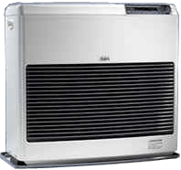 Requires vents to the outside.c
Requires vents to the outside.c- Available in medium- or high-output models ranging from 25,000 to 65,000 BTUs/hr.
- Includes an enclosed radiating circulator unit with tempered glass in front of a series of radiants.
- Designed to take up medium space.
- Popular with consumers seeking to trim heating bills.
Non-Vented Gas Heater
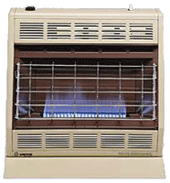 Requires no outside vent.
Requires no outside vent.- Suitable for zone heating and is clean burning and inexpensive to operate.
- Uses an oxygen depletion sensor (ODS). This device shuts off the heater and the flow of gas to the burner if the oxygen level in the room becomes inadequate. An ODS is required on all unvented heating equipment.
- Infrared-type heaters of this type use a ceramic radiant or panel that is positioned above the gas burner. The ignited gas gives off a bright orange glow to produce heat. A screen-like guard protects the radiant plaques but they are not otherwise enclosed.
- Convection-type heaters of this type first warm the air, which then warms the objects. Has burners enclosed within a painted or enamel-coated sheet metal housing that has air openings on the top, front and possibly the sides.
Kerosene Heater
 Uses a wick rather than a pressure-fed fuel system.
Uses a wick rather than a pressure-fed fuel system.- Standard features include an automatic shut-off device to extinguish the flame if the heating unit is bumped or jarred, grills or guards to keep hands away from the surface and push-button battery-powered lighting devices.
- Some areas do not allow the use of this type of heater. Check with local government agencies.
- Only use K-1 clear kerosene fuel. Yellow or colored fuel will smoke, smell and hamper wick operation.
Duct Fan
 Boosts the flow of air from the central heating system to areas in a house that are hard to heat or cool.
Boosts the flow of air from the central heating system to areas in a house that are hard to heat or cool.- Overcomes the added resistance in long duct runs.
- The prop fan type fits inside the duct.
- The squirrel cage type fan has the motor mounted outside of the duct.
- Most models vent about 200 cubic feet per minute in 6” to 8” diameter ducts.
- Wired in series with the central furnace blower or operated by an auxiliary thermostat.






